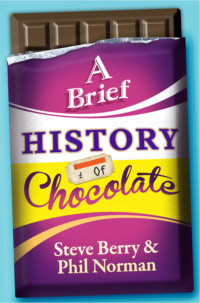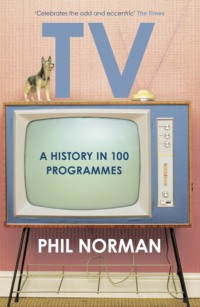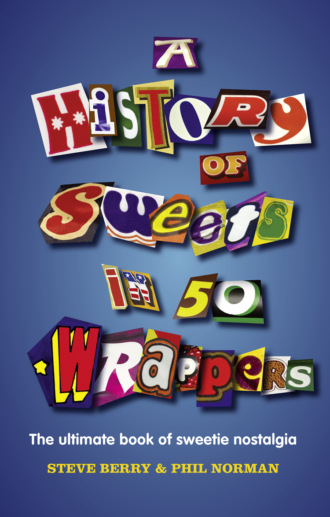
Полная версия
A History of Sweets in 50 Wrappers

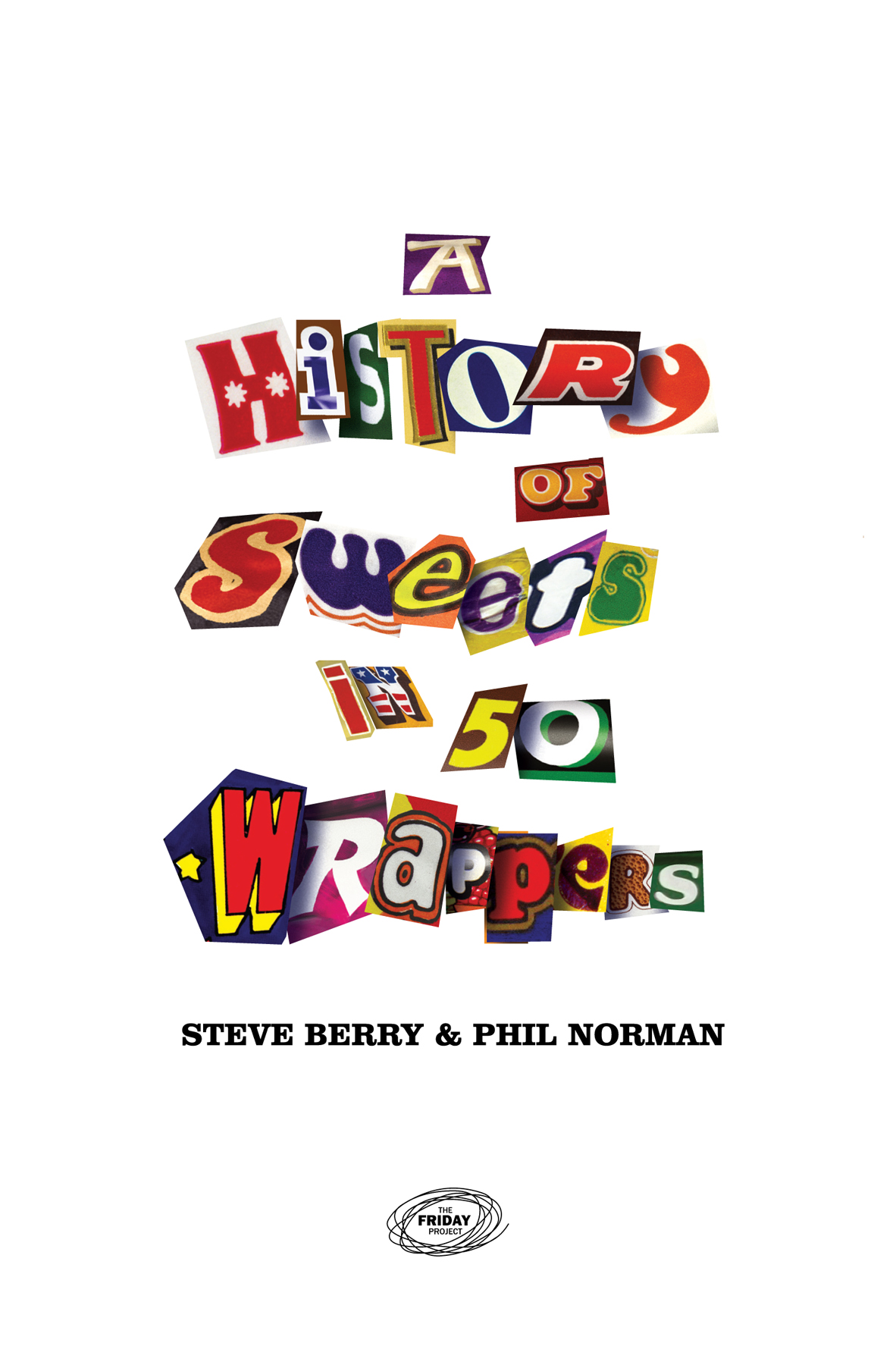
Copyright
Image cedits Confectionery collections: Lucy Bernstein, John Estlea, Dan Goodsell, Darren Wallington. Comic pages: Combom, Steve Hearn, Alistair McGown. Badges: Frank Setchfield.
First published in Great Britain in 2014 by
The Friday Project
An imprint of HarperCollinsPublishers
77–85 Fulham Palace Road
London W6 8JB
www.harpercollins.co.uk
Some of the content of this book originally appeared in The Great British Tuck Shop, published by The Friday Project in 2012
Copyright © Steve Berry and Phil Norman 2014
The right of Steve Berry and Phil Norman to be identified as the authors of this work has been asserted by them in accordance with the Copyright, Designs and Patents Act 1988
A catalogue record for this book is available from the British Library
ISBN 9780007575480
All rights reserved. No part of this publication may be reproduced, transmitted, or stored in a retrieval system, in any form or by any means, without permission in writing from The Friday Project.
Cover design by Luana Gobbo
Illustrations by Jumping Bean Bag Ltd
Ebook Edition © 2014 ISBN: 9780007575473
Version: 2014-09-23
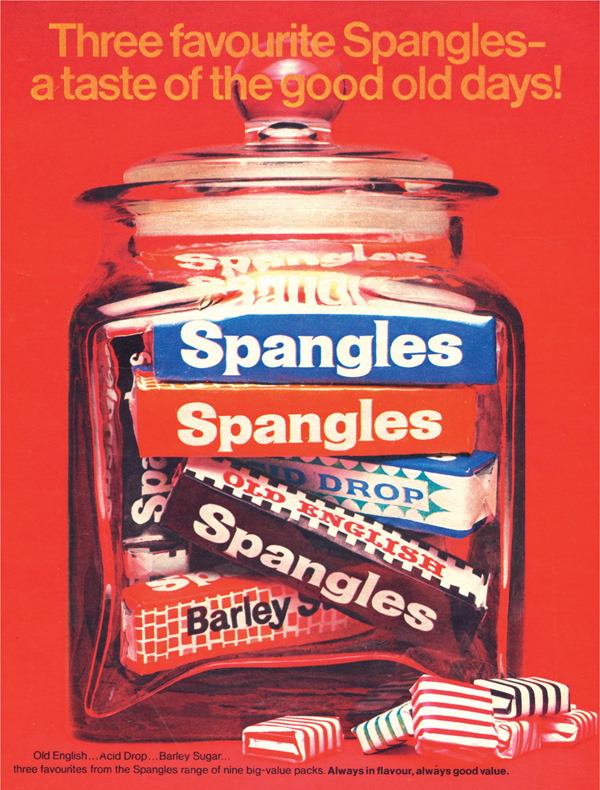
Dedication
For Suzy, Joanna & Joanne
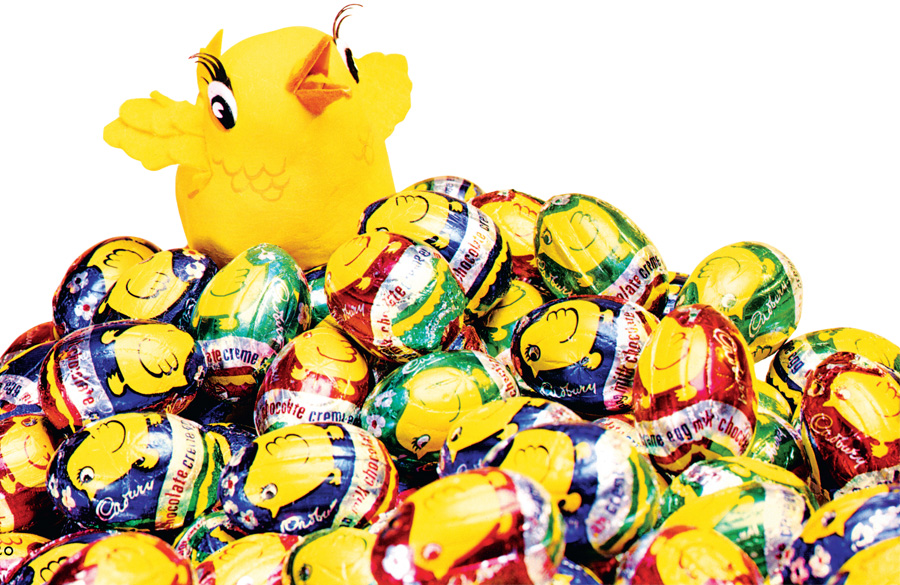
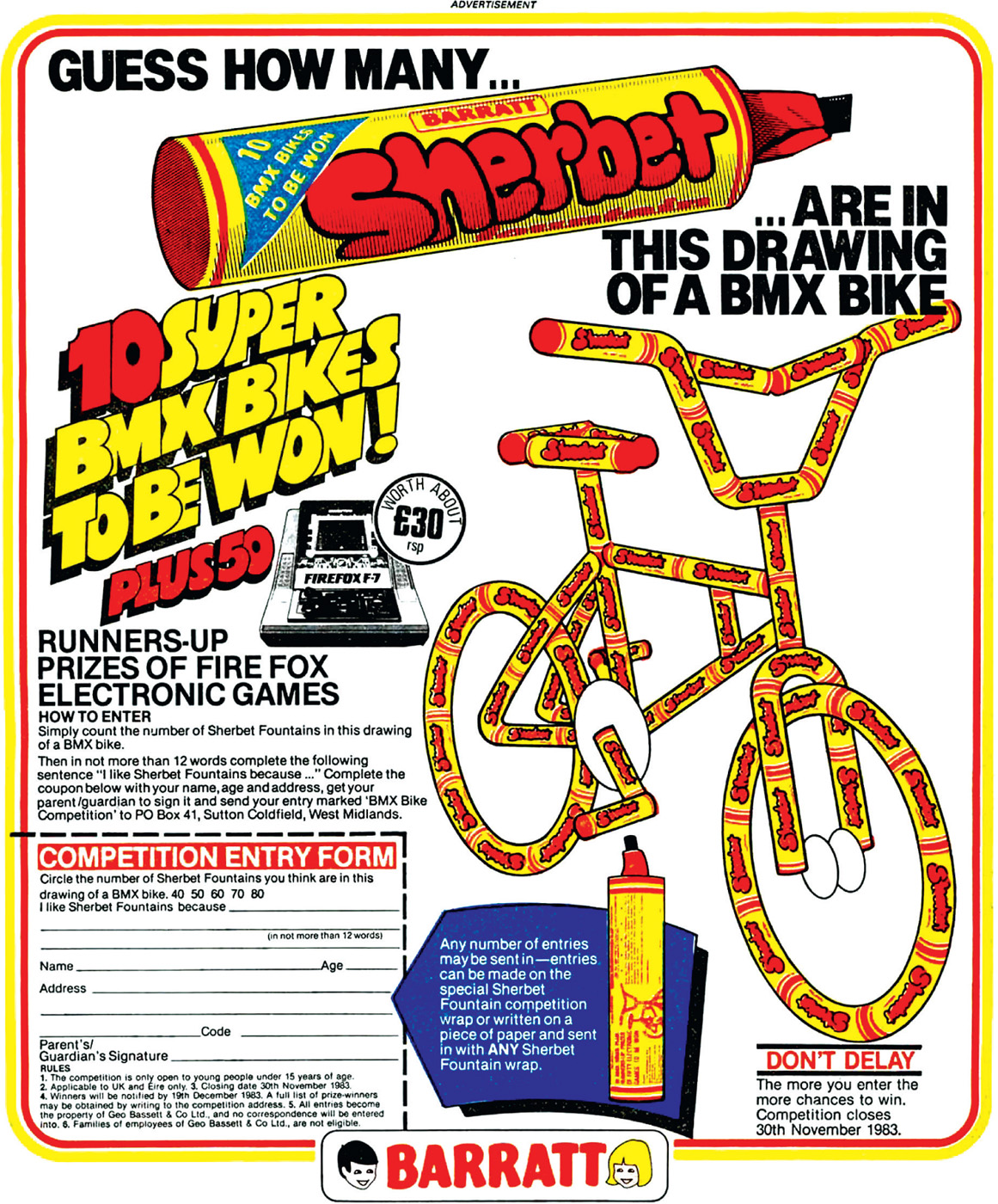
Contents
COVER
TITLE PAGE
COPYRIGHT
DEDICATION
INTRODUCTION
AERO
AZTEC
BOUNTY
CADBURY’S CARAMEL
CARAMAC
CHEWITS
COUNT DRACULA’S DEADLY SECRET
CREME EGG
CRUNCHIE
CURLY WURLY
DAIRY MILK
DIME
DOUBLE AGENTS
DOUBLE DECKER
EXTRA STRONG MINTS
FAB
FLAKE
FOX’S GLACIER MINTS
FREDDO
FRY’S FIVE CENTRES
GOLD RUSH
IPSO
JUBBLY
KINDER SURPRISE
KIT KAT
LOVE HEARTS
MARS
MILKY BAR
PACERS
PICNIC
POLO
REESE’S PIECES
REVELS
ROLO
ROWNTREE’S FRUIT GUMS AND PASTILLES
SHERBET FOUNTAIN
SMARTIES
SPACE DUST
SPANGLES
TERRY’S ALL GOLD
TEXAN
TOBLERONE
TOFFO
TURKISH DELIGHT
TWIX
VIMTO LOLLY
WALNUT WHIP
WHAM
WISPA
YORKIE
ACKNOWLEDGEMENTS AND THANKS
ABOUT THE PUBLISHER
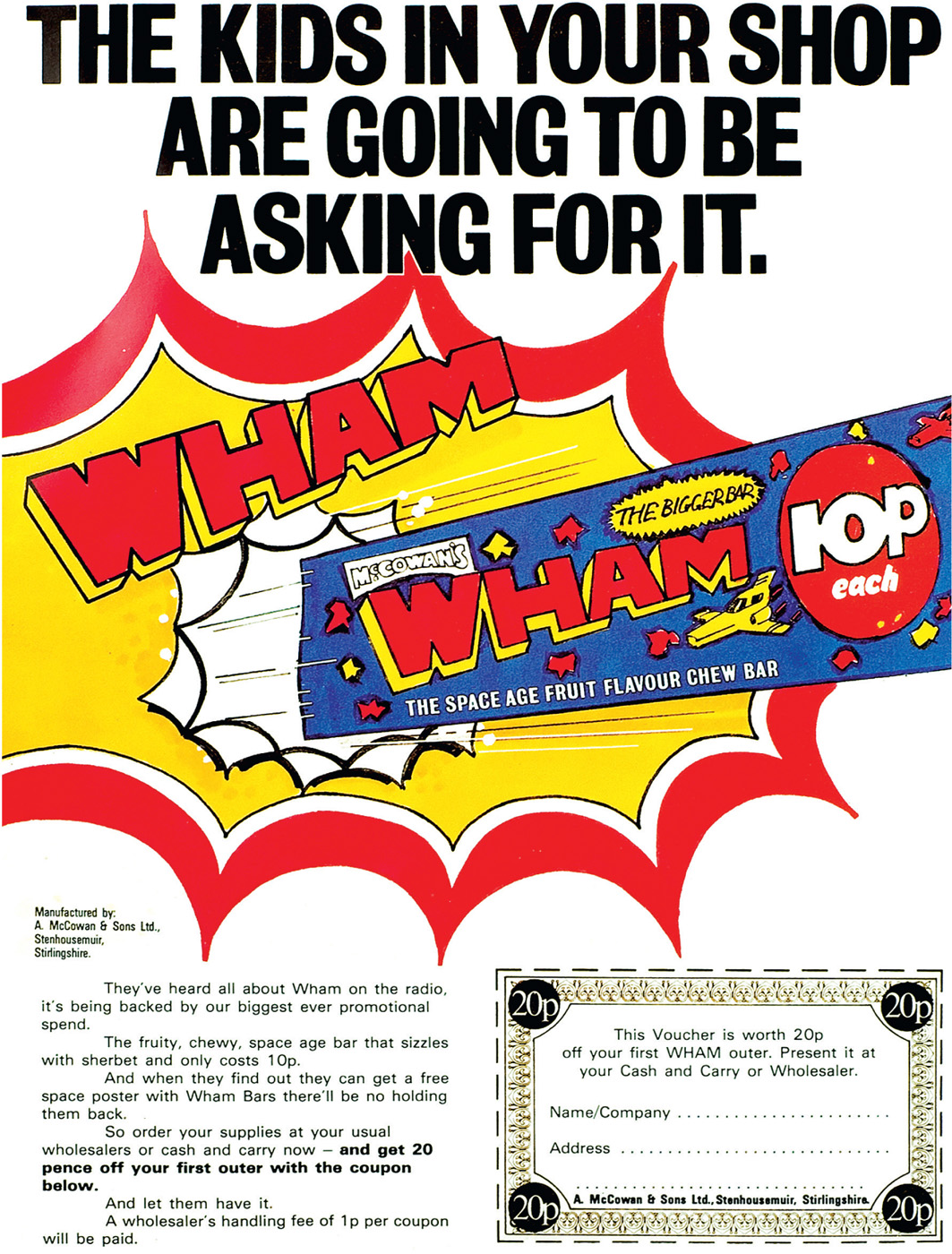
INTRODUCTION
For anyone of a certain age, memories of childhood are irrevocably connected to the stomach. The sweet shop was a great leveller. Everyone shopped there, from the Walter Softies to the Bully Beefs (although the bullies would probably steal the softies’ sweets, too). If you were a Milky Bar kid, a Flake girl or one of Fry’s Five Boys, it’s likely that the very first purchase you made with your very own money was something to eat.
There are two acknowledged golden ages of British confectionery. The first came in the 1920s and 1930s when, despite the Depression, the big sweet makers consolidated their brands and expanded nationwide. The second came in the 1970s and 1980s when, despite the Depression, the big names of sweets let their development departments go (fruit and) nuts, shunting out celebrity-endorsed chocolate bars and cartoon-wrapped nougat delights on a weekly basis.
Manufacturing went Technicolor, all the better to catch the wavering eye and stick in the mind for years to come. Sweet shops, until then like antique shops – arthritic, grey and fusty, trapping sunbeams in dust and quietly ossifying – were transformed into glittering Aladdin’s caves, crammed to the rafters with individually wrapped sugared treasures.
Somewhere between decimalisation and globalisation, creative confectionery enjoyed its most fertile period – an auspicious era that began with the last manned moon mission and ended as the first Sky channels beamed into unsuspecting British homes. That journey to the corner shop took on the nature of a pilgrimage for many a child, with a salivating smile and a skipping heartbeat. Inside, a fantastic cornucopia of riches. Some items had a past longer than the shopkeeper himself. Others would go on to outlive him. While many, with hindsight, would never see the year out.
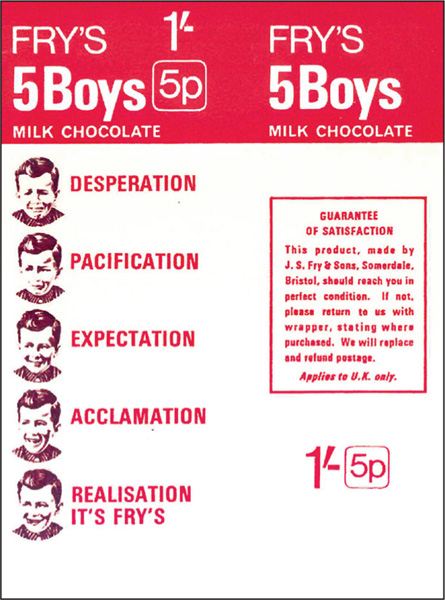
‘Oh, pish, tush and a cheap laugh during a slow edition of QI! It’s Fry’s Five Boys (1902).
None of this mattered to your prospective sweet purchaser, gloriously transfixed as they were in the moment, surveying the ranks of stock. Iconic Mars bars sitting next to the doomed likes of the Cadbury’s Alamo. The Fruit Salad chew, old as the Book of Genesis, shared shelf space with Trebor’s Fings, Rowntree’s Junglies and other sugary mayflies. In the disinterested eyes of the proprietor, all products, as long as someone bought them, were equal. No preferential treatment here. You had to choose wisely, as funds were limited. Governmental sweet rationing may have ended in 1953, but the economic and parental varieties still held sway.
Many products came and went – mere footnotes in their manufacturers’ inventories – but that doesn’t mean they weren’t coveted, adored, consumed with a passion and, just like old friends, noisily revisited a few hours later on the waste ground behind the prefabs. Fortunately a lot of them tasted the same coming up as going down.
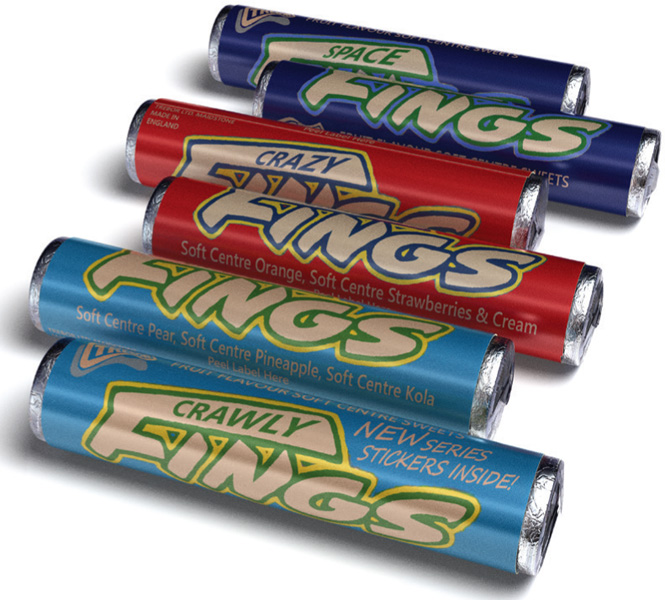
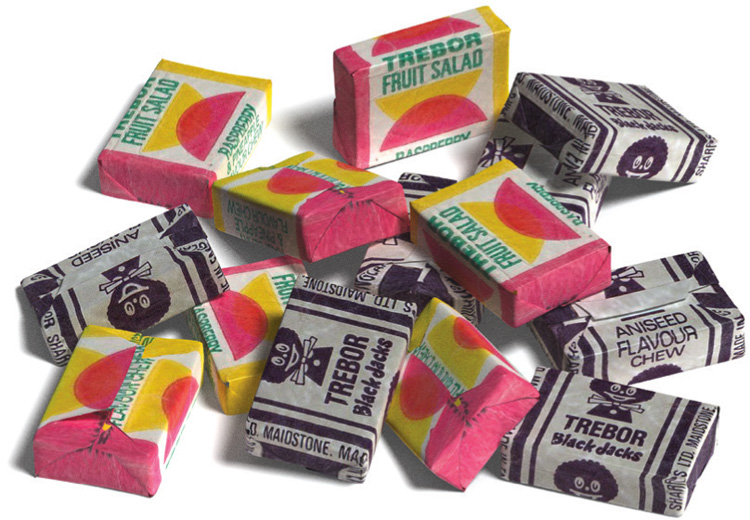
Fings ain’t what they used to be (1981), not least for the racist packaging of Trebor’s Black Jacks (1920).
The marketing men inevitably loom large in this tale, coupling childlike imagination with ruthless raiding of money boxes to create a world of hedonistic abandon, populated by models, mascots and maniacal showbiz personalities all merrily hooked on the product – whatever it may be – and keen to let the whole world know. Often in full song.
For better or worse, their efforts made a generation what it is, and what follows is, as much as anything else, an account of how they focus-grouped our Five Centres.
Those big companies can’t help but tinker with their winning brands, all in the name of progress. Recipes are changed, formulas are tweaked, and – most heinously of all – the packaging is modernised. Do not despair. Despite the disappearance of some cherished childhood chocolate bars, many sweets, crisps, snacks and pop are still available if you look hard enough. Only the artificial colours and preservatives have been jettisoned, in favour of ‘all natural’ ingredients.
Don’t believe those people who wax lyrical about the good old days of gobstoppers the size of your head, either. No, those Creme Eggs haven’t got smaller. Your hands have got bigger. In fact, with very few exceptions, the tuck shop fare of youth is served in heftier portions than ever before, as the waddling, wobbling outlines of twenty-first-century obesity crises serve to illustrate.
So here it is, then, your very own unnatural preservative of the best of the Great British sweet shop. Go ahead, dive in – but don’t spoil your tea, now.

Munchies (1957), Mackintosh’s crunchy answer to Rolo. Stablemates Mintola and Delight not pictured.
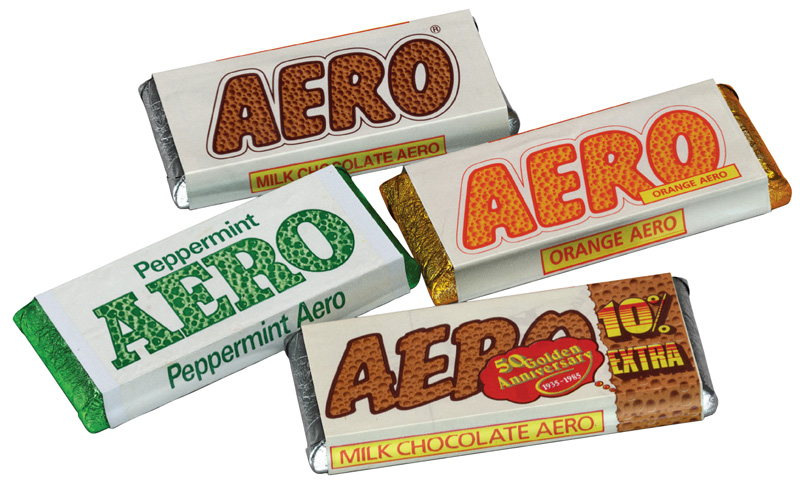
‘Unforgettabubble, that’s what you are. Unforgettabubble, milk chocolate bar.’ A line of old King Cole for Rowntree’s Aero (1935).
AERO
For all the Wonka-esque mystique affected by chocolate makers, most confectionery innovations amount to ‘let’s bung this on top of this, stick some chocolate on it’. The invention of the Aero, however, really did involve science. Rowntree’s technicians frothed up some liquid chocolate with a whisk, poured it into moulds and then – the clever bit – reduced the surrounding air pressure drastically so the tiny bubbles of froth swelled up to a decent size. Then it was a matter of passing the moulds through ice-cold water to set, covering the result with a layer of solid chocolate, and the job was done.
It caused a sensation when it came out, albeit one helpfully whipped up by Rowntree themselves. The exciting new texture, they claimed, ‘stimulates the enzyme glands’ – a bit of shameless quackery they were soon forced to take back. Initially great sales began to tail off, in part due to an assortment of rivals appearing on the scene with undue haste, in particular Fry’s two tryouts, the Ripple and the All-Chocolate Crunchie. Add to that a disputed patent, and things got panicky at Rowntree headquarters. Fruit and nut and whole nut variants were hurriedly bunged out to support the ailing novelty. Sales levelled off after a while, and the Aero, while no longer a craze, remained steady-as-she-goes.
They couldn’t resist mucking about, though. An Aero Wafer introduced in 1950 didn’t hang about too long, but in ’59 the bright idea of changing the aerated centre from chocolate to peppermint gave the bar a new lease of life, and with orange and coffee centres arriving over the next couple of years, a nice little family was built up that would tick over happily for decades, with just a new campaign based around the word ‘bubbles’ knocked out every few years. Oh, and a short-lived lime variant in 1971.
Then, cometh the ‘80s, cometh the Cadbury’s Wispa. Big trouble in Rowntreeland as the potential Aero spoiler was worriedly picked over. Luckily the two-year gestation period Cadbury took to get the Wispa going nationwide allowed Rowntree to remake the Aero in its image. By September of 1982, gone was the six-segmented flat format, a bumpy chocolate version of the traffic-calming measures in a well-to-do Cotswold village. In came the handy ingot size. In the process, something – no one was quite sure what – changed. The chocolate had become softer. No, the bubbles were bigger. No, it’s the taste... It scarcely mattered, as the new bar more than held its own against the Bournville parvenu. But even today, plenty of former stalwart Aerovians feel slighted by the changes, their enzyme glands no longer stimulated in quite the same way.
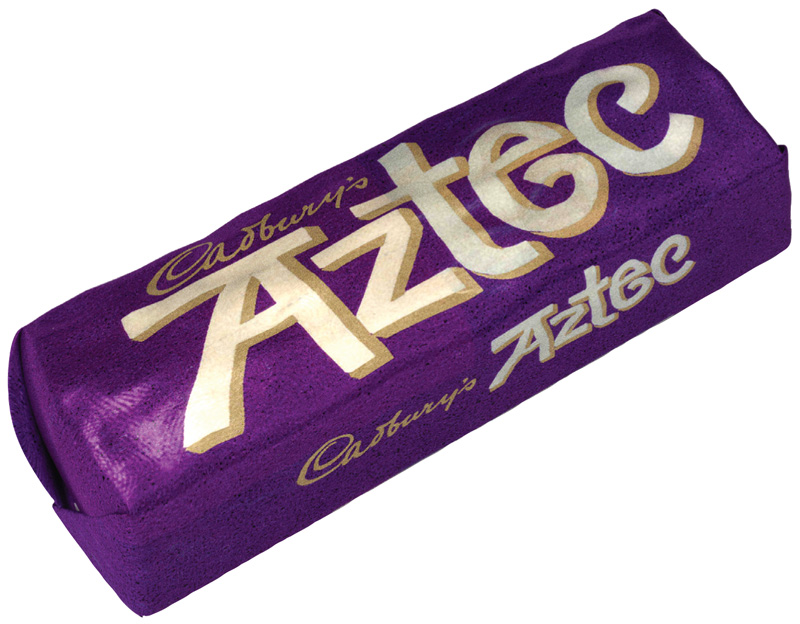
A sign of civilisation. Aztec (1967), swiftly sacrificed to the gods of chocolate nostalgia.
AZTEC
This is a tale of two cultural cornerstones. On the one hand, the mighty Quetzalcoatl, feathered serpent god of the ancient Aztecs, who gave his people the sacred gift of chocolate via a beam of heavenly light, bringing them universal wisdom and Type 2 diabetes. (Sadly, the one bit of knowledge that might have been some use, namely ‘If you see these Spanish blokes with big shiny helmets, run like the clappers,’ slipped the feathered one’s mind.) In the blue corner, there’s the equally legendary rival to the Mars bar, opportunistically cooked up by Cadbury in a lean period and promoted with a travelogue-swish TV campaign filmed at one of your actual Mexican temples, only to vanish mysteriously four years later. The former lived on for centuries in folk memory and overpriced Acapulco gift shops. The latter enjoyed a similarly fertile afterlife, becoming the de facto nostalgic touchstone for the first wave of alternative comedians (Ben Elton’s swing-top bin was so long unemptied it had ‘Aztec wrappers in the bottom’).
It’s perhaps fair to say that Elton’s championing of fair-trade didn’t tally too well with the Aztec’s imperialistic undertones, a state of affairs not helped by the life-size cardboard warrior chieftains installed in newsagents the nation over, to the innocent delight of kids who’d gleefully perform a culturally inaccurate whooping war dance around them. All this happened, of course, while the Milky Bar kid was doing his bit for the Native North Americans. To complete the continental clean sweep, the 1980s, when you’d have thought people would have calmed down a bit, saw the launch of the otherwise unremarkable Rowntree’s Inca. We could, of course, all be very smart and ironic about such things by the time the Aztec made the slightest of slight returns in the year 2000.
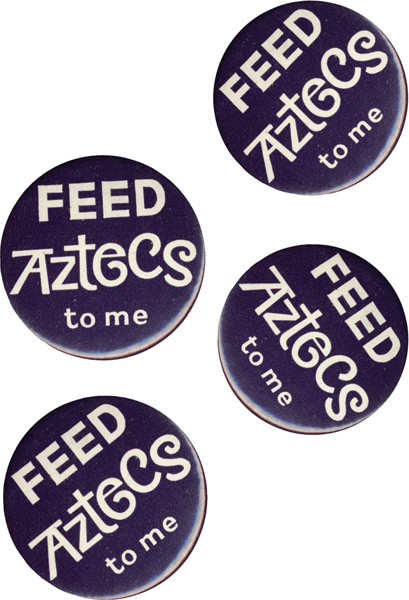
Instigating a Mexican crave. Safety-pin propaganda on behalf of Cadbury.
Конец ознакомительного фрагмента.
Текст предоставлен ООО «ЛитРес».
Прочитайте эту книгу целиком, купив полную легальную версию на ЛитРес.
Безопасно оплатить книгу можно банковской картой Visa, MasterCard, Maestro, со счета мобильного телефона, с платежного терминала, в салоне МТС или Связной, через PayPal, WebMoney, Яндекс.Деньги, QIWI Кошелек, бонусными картами или другим удобным Вам способом.


